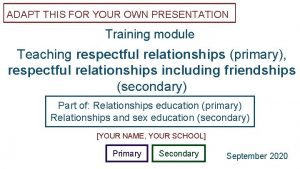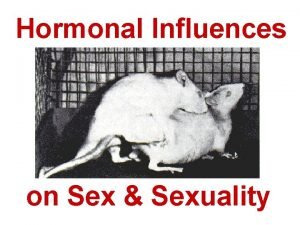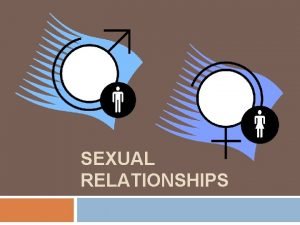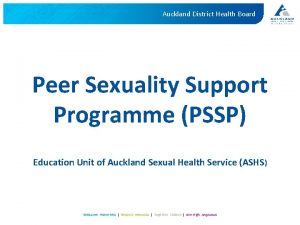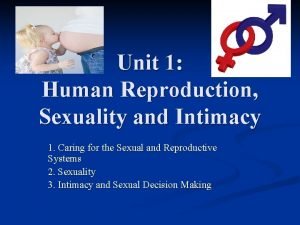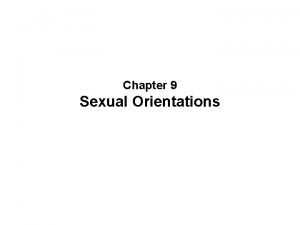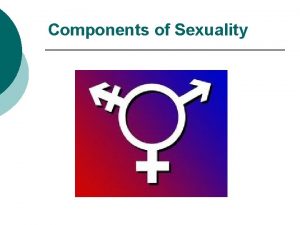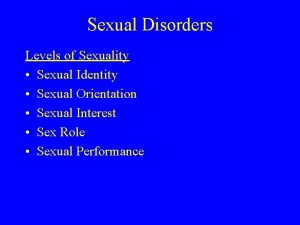LESSON 1 Sexuality Sexual Orientation and the Human


















- Slides: 18

LESSON 1 Sexuality, Sexual Orientation, and the Human Sexual Response Lesson 1 Sexuality, Sexual Orientation, and the Human Sexual Response

Journal Question Do you think sex education should be taught in the schools? Explain your response. Are there certain sex education subjects you do or do not think should be taught in the school? What are they? Why do you think the subjects you listed should or should not be taught in the schools?

Sex Education • Sex education in schools is a controversial topic for some people. • Even though national polls indicate a majority of U. S. students and parents favor sex education in the schools, many still lack effective sex education. • National Sexuality Education Standards address the inconsistent implementation of sexuality education nationwide and the limited time allocated to teaching the topic. • Much of the information for this chapter is based on the National Sexuality Education Standards.

Sexuality and Sex • The terms sexuality and sex refer to the feelings, thoughts, identities, sensuality, intimacy, and reproduction of people. • Can include being attracted by and attractive to others, being in a relationship, and being in love.

Changing Cultural Norms • Average of marriage in U. S. is increasing: – 28 for men and 27 for women • Teen birth rates in U. S. lowest in 70 years. • According to the Centers for Disease Control and Prevention (CDC), 43% of unmarried teen girls and 42% of unmarried teen boys surveyed between the ages of 15 and 19 had admitted to having sex.

Age of Consent • It is the age at which a person can legally consent to being sexually active. • Age of consent varies by state; some are 16, others are 17, and still others are 18.

Influences on Human Sexuality • Our view of sexuality is influenced by family, friends, school, culture, society, religion, Internet, movies, TV, and other forms of media. – Much of it is not entirely accurate. (continued)

Influences on Human Sexuality (continued) • Between 2006 and 2008 among teens aged 15 to 19: – 93% received formal instruction about STIs. – 89% received formal instruction about HIV. – 84% received formal instruction about abstinence. – Approximately 67% have received formal instruction on contraception. (continued)

Influences on Human Sexuality (continued) • Many students vow not to have sex before they are married, but when faced with sexual temptation the vow tends to weaken. • Students in abstinence-only programs are less likely to use contraceptives because they don’t know about them. This increases the risk of unwanted pregnancy and STIs. • Students who are taught how to prevent pregnancy and STIs are more likely to practice safer sex.

Sexual Orientation • The American Psychological Association (APA) defines sexual orientation as “an enduring pattern of emotional, romantic, and/or sexual attractions to men, women, or both sexes. ” • Three primary categories of sexual orientation: – Heterosexual: attracted emotionally and sexually to the opposite sex – Gay and lesbian: attracted emotionally and sexually to the same sex – Bisexual: attracted emotionally and sexually to both men and women (continued)

Sexual Orientation (continued) • The APA states “there is no consensus among professionals and scientists about the exact reasons that an individual develops a heterosexual, bisexual, gay, or lesbian orientation. ” – Researchers think both nature and nurture play a role in an individual’s sexual orientation because most experience little or no sense of choice in their sexual orientation. (continued)

Sexual Orientation (continued) • LGBTQ refers to people who are lesbian, gay, bisexual, transgender, and questioning (unsure of their sexual orientation or gender identity). • Many LGBTQ individuals experience prejudice and discrimination that can cause negative psychological effects. – Many schools, universities, and government entities now have anti-discrimination policies or laws. – Some states permit same-sex marriages and allow samesex couples to adopt children.

Human Sexual Response • Four stages: 1. Excitement phase 2. Plateau phase 3. Orgasm phase 4. Resolution phase • All phases may or may not happen each time a person is sexually stimulated. • The time in each phase varies from person to person and within the same person.

Human Sexual Response: Excitement Phase • People may be stimulated by sight, sound, touch, smell, taste, imagination, or a combination of any of these. • Physiological changes in both males and females: – Heart rate increases, muscles tense, skin may become flushed, nipples may become erect, and blood flow to the genitals increases, specifically to the clitoris and labia minora in women and to the penis in men. • Duration of this phase ranges from less than a minute to more than an hour.

Human Sexual Response: Plateau Phase • An extension of the excitement phase. • In both males and females more blood flows to the genitals; breathing, heart rate, blood pressure, and muscle tension increase. May experience muscle spasms in the hands, feet, or face. • Phase may last from several minutes to hours.

Human Sexual Response: Orgasm Phase • Orgasm is a subjective experience of intense pleasure and sexual climax and release. • Female orgasms involve muscular contractions in the vaginal walls, the uterus, and sometimes the anus. • Male orgasms are the same thing as ejaculation in which fluid from the seminal vesicles and sperm are ejaculated through muscle contractions in the urethra. • While many view orgasm as the ultimate goal of sexual intercourse, many people do not experience orgasm. • Shortest phase of the human sexual response cycle. May last approximately 3 to 8 seconds.

Human Sexual Response: Resolution Phase • Body returns to the unstimulated state. – Blood leaves the genitals and the heart rate, breathing rate, and blood pressure return to normal. – The psychological arousal of the experience will also subside, usually leaving a person in a state of relaxation. • The body will usually return to its unstimulated state in approximately 15 minutes.

Masturbation • The self-stimulation of the genitals (penis or clitoris, sometimes vagina) to achieve sexual arousal and pleasure. • Masturbation is normal, healthy, and common among men and women in U. S. society. • Masturbation can be used to relieve sexual tension, to experience pleasure, and to provide a safe sexual alternative for people who wish to avoid pregnancy and sexually transmitted infections.
 Sex ap psychology
Sex ap psychology Sexual orientation gender identity
Sexual orientation gender identity Sexual orientation stereotypes
Sexual orientation stereotypes Polycentric geocentric regiocentric ethnocentric
Polycentric geocentric regiocentric ethnocentric Pretest: growth, development, and sexuality
Pretest: growth, development, and sexuality Chapter 10 sex gender and sexuality
Chapter 10 sex gender and sexuality Androgen insensitivity
Androgen insensitivity Sex and gender difference
Sex and gender difference Sexuality in advertising
Sexuality in advertising Jowelle de souza
Jowelle de souza Awareness, acceptance and comfort with one’s own body
Awareness, acceptance and comfort with one’s own body Definition of sexuality
Definition of sexuality Definition of sexuality
Definition of sexuality Which illustrates an emotional aspect of teen sexuality?
Which illustrates an emotional aspect of teen sexuality? Peer sexuality support programme
Peer sexuality support programme Base of uterus
Base of uterus Sexuality spectrum
Sexuality spectrum Sexual reproduction in human
Sexual reproduction in human Reproduction
Reproduction


